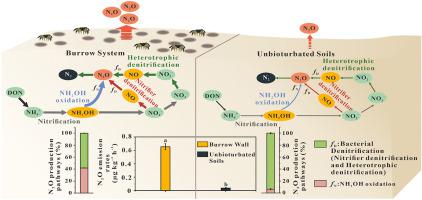Soil Biology and Biochemistry ( IF 9.8 ) Pub Date : 2022-05-25 , DOI: 10.1016/j.soilbio.2022.108732 Zhirui An , Yanling Zheng , Lijun Hou , Dengzhou Gao , Feiyang Chen , Jie Zhou , Bolin Liu , Li Wu , Lin Qi , Guoyu Yin , Min Liu

|
Coastal wetlands are hotspots for nitrogen (N) cycling and a significant natural source of the potent greenhouse gas nitrous oxide (N2O). Burrowing benthos are known to transform N in intertidal marsh soils, but their contribution to N2O emissions and the underlying molecular mechanisms remain unclear. Here, the effects of crab bioturbation on N2O emissions in coastal marshes, where Chiromantes dehaani and Helice tridens tientsinensis were the dominant crab species, were investigated in field and indoor experiments. The N2O emissions increased significantly in the presence of crabs, being positively correlated with the intensity of crab bioturbation but differing among crab species. Natural-abundance isotope analyses indicated that crab bioturbation greatly promoted the contribution of hydroxylamine oxidation to N2O production; nevertheless, bacterial denitrification (including heterotrophic denitrification and nitrifier denitrification) remained the dominant pathway. Molecular analyses suggested that the increased N2O emissions in crab-disturbed habitats might be driven by underlying changes to microbial communities, especially by the disproportionate stimulation of nitric oxide reductase-carrying microbes over nitrous oxide reductase-carrying microbes. This study highlights the importance of considering the burrowing activity, density, and species of benthos when evaluating the N cycle in coastal wetlands.
中文翻译:

潮间带沼泽土壤中穴居蟹活动导致的一氧化二氮排放加剧:机制和环境影响
沿海湿地是氮 (N) 循环的热点,也是强效温室气体一氧化二氮 (N 2 O) 的重要天然来源。已知穴居底栖生物在潮间带沼泽土壤中转化 N,但它们对 N 2 O 排放的贡献和潜在的分子机制仍不清楚。在这里,在田间和室内实验中研究了螃蟹生物扰动对沿海沼泽地N 2 O 排放的影响,其中Chiromantes dehaani和Helice tridens tientsinensis是主要的螃蟹物种。N 2在螃蟹存在的情况下,O 排放量显着增加,与螃蟹生物扰动的强度呈正相关,但在螃蟹种类之间存在差异。自然丰度同位素分析表明,螃蟹生物扰动极大地促进了羟胺氧化对N 2 O 产生的贡献;尽管如此,细菌反硝化(包括异养反硝化和硝化菌反硝化)仍然是主要途径。分子分析表明,增加的 N 2受螃蟹干扰的栖息地中的 O2 排放可能是由微生物群落的潜在变化驱动的,尤其是携带一氧化氮还原酶的微生物对携带一氧化二氮还原酶的微生物的不成比例的刺激。本研究强调了在评估沿海湿地 N 循环时考虑洞穴活动、密度和底栖动物种类的重要性。











































 京公网安备 11010802027423号
京公网安备 11010802027423号